Webasto strengthens e-mobility support in U.S.
09 December 2022
North American team equipped to offer application engineering, support
It’s been four years since Webasto showed its lithium-ion battery pack to the North American market at a tradeshow in Las Vegas. In the time since then, and by nearly every measure, the bet it placed on electromobility is paying off.
“We’re growing in the e-mobility space and our future plans are very much tied to our continued growth in e-mobility,” said Taylor Hansen, president and CEO of Customized Solutions – Americas Region, Webasto Group, Fenton, Mich.
 Taylor Hansen (Photo: Webasto)
Taylor Hansen (Photo: Webasto)
Family-owned Webasto Group was founded in Germany in 1901 and posted 3.7 billion euros in sales last year. Having set a goal to develop e-mobility into the company’s second pillar – the first being its automobile roof system business which represented 83% of its global sales in 2021 – it introduced the High Voltage Heater (HVH) for electric vehicles in 2014 and a lithium-ion battery pack two years later.
When it comes to automobile roof systems — think panoramic tops, sunroofs and convertibles — the company works with most OEMs around the world. For example, in Michigan the company developed and manufactures roof systems for the Chevrolet Corvette C8 and the Ford Bronco – the latter in a dedicated factory in Plymouth.
Standard battery pack
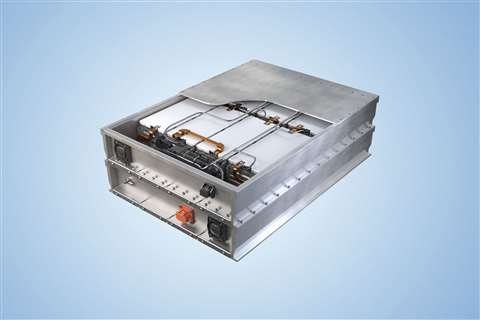 Webasto CV standard battery. (Illustration: Webasto)
Webasto CV standard battery. (Illustration: Webasto)
Webasto created a 900 hp battery-electric Ford Mustang for the 2019 Specialty Equipment Manufacturers Association (SEMA) Show in Las Vegas. Through that powerful introduction (the Mustang was also seen a few months later at Work Truck Week in Indianapolis), the company announced its plans to become a supplier of battery-electric systems for the commercial vehicle and off-highway equipment markets. The CV (commercial vehicle) standard battery system continues to lead the charge today, and it’s been joined by a range of related components and technology.
To meet growing demand, the company has invested in new product development, manufacturing and testing and verification. The battery is impact resistance tested at up to 100 kilonewtons and has an IP 67 rating for watertightness. In Europe, it received a CE mark for its standard battery system and its Vehicle Interface Box (VIB) with the European Low Voltage Directive (2014/35/EU) and the EMC Directive (2014/30/EU), as well as compliance with the standards EN 62619 and EN 62485-6. The latter two standards specify the safety requirements for lithium-ion batteries in traction and industrial applications.
“We have capitalized on our existing know-how to further develop our portfolio for future applications.” said Hansen, “That’s not just batteries and chargers, it’s also digital services such as telematics. Now the relevance of our product line is quite apparent in anything from mining to marine to medium-duty trucks because it’s a plug-and-play system and because it’s already validated.
“Potential customers ask us about the battery, and when they realize a lot of their work has already been done — versus what it would cost them to do that work in-house — they’ve replied with some really big RFQs.”
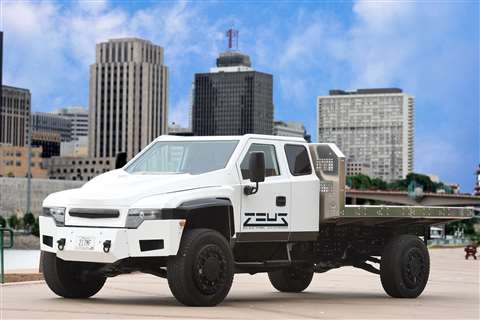 Based in Minnesota, Zeus Electric Chassis was an early adopter of Webasto’s lithium-ion battery system for its Z-19 medium-duty truck. (Photo: Zeus Electric Chassis).
Based in Minnesota, Zeus Electric Chassis was an early adopter of Webasto’s lithium-ion battery system for its Z-19 medium-duty truck. (Photo: Zeus Electric Chassis).
Local support
For the work that needs to be done yet – such as the engineering that’s required to install a battery and its ancillary systems into a machine that is safe, dependable and marketable, Hansen helped build a dedicated sales, engineering and support team based in the Detroit metro area to support battery electrification and thermal management work in the United States.
“Now we have the local support at each level needed to support an OEM’s applications from initial discussions through their serial production startup,” said Jason Bowles, a long-time Webasto engineer who now leads the battery development team in Fenton. “We have every one at each needed position in place here. Now when an OE wants to work with us, they’re getting a local contact that’s going to take them through every step from initial discussion through to their vehicle driving down the road or doing whatever it was designed to do. When a customer calls, we pick up the phone and they’re not just calling a hotline.”
When the phone is answered, Bowles said they’ve found the EV knowledge possessed by the caller can vary widely. “It could be a very experienced team that calls us and says, ‘We need this,’ and all we have to do is answer their questions and we’re off to the races. Sometimes we have to coach them a little bit more. The vast majority know what they want so it’s quite easy to give them the initial data they need, such as what our battery can attain for them. Some of the smaller companies will use an integrator that has experience in this technology. Everyone needs to learn to crawl before they walk, so it’s good to have those integrators involved, too.”
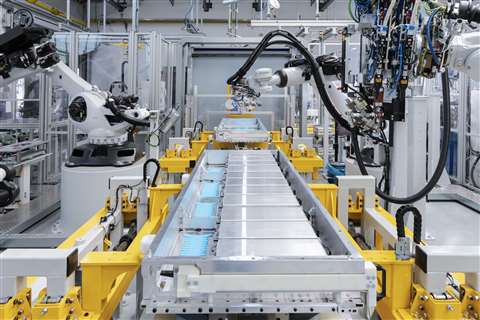 Battery packs are assembled automatically in Webasto’s Schierling, Germany, factory. (Photo: Webasto)
Battery packs are assembled automatically in Webasto’s Schierling, Germany, factory. (Photo: Webasto)
Battery system catalog
“We enable smaller players with lower volumes, even if they’re higher value pieces of equipment like mining, to be electrified so their equipment can have less of an environmental impact,” said Hansen. “Some want to retrofit their existing equipment, and they find that working with Webasto is different than going to a competitor who will just sell a battery. We offer the battery and the battery management system, the power distribution unit and thermal management system. We have a solution that is an integrated system that is scalable and modular.”
The company said its CV battery combines the price benefits of a mass-market product with the precision fit of a custom solution. Each pack has a capacity of 35 kWh, and up to 18 packs can be interconnected. The batteries can be utilized in both 400- and 800-volt systems.
“There’s only three moving parts in the whole battery and it looks like a Lego block with a couple connectors, but when you open it up, you’ll see there’s thousands of hours of engineering inside,” said Bowles. “The beauty and elegance of good design is that it looks simple on the outside. The reference I always use when talking about batteries is an iPad. An iPad is simple to use and elegant but it’s very complicated when you take off that cover. Integrating it into a machine is a packaging efficiency exercise and then the job is to make sure everything works the way we want it. While that sounds simple, it’s very complex in its criteria and requirements so it can take quite a bit of time.”
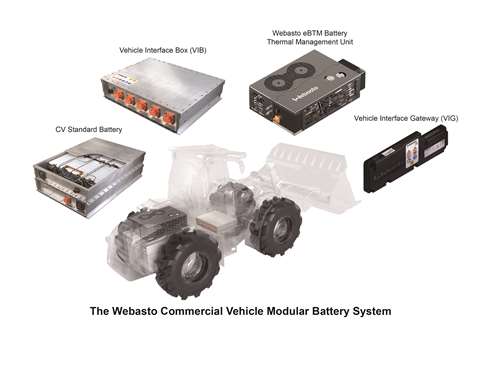 Illustration: Webasto
Illustration: Webasto
The VIB serves as an interface between the battery system and the vehicle. It combines the functions of a power distributor, master battery management system (BMS) and fuses. The more compact Vehicle Interface Gateway (VIG), which has been on the market since June, also has a BMS function. The VIG can be used to map up to nine battery packs in a 400-volt system and up to 18 battery packs in an 800-volt system, offering a total capacity of up to 630 kWh.
“With our system, you have three options,” said Bowles. “You can use our VIB, which is a master brain for the person who either knows exactly what they want, or they don’t have the time, money and expertise to develop the hardware. They also have the option of using the VIG, which is our expert integration level, because you just want the battery and you can handle the rest with your own hardware. And then you could just use the battery by itself, but that gets very complex.”
The company’s Field Data Monitoring (FDM) allows data from the battery to be collected, transmitted, stored and visualized so users can monitor their health and obtain extended warranty services via an additional product.
The eBTM 2.0 is a stand-alone device for the thermal management of traction batteries. With a heating capacity of 10 kW and a cooling capacity of 8 kW, the company said it can extend the pack’s service life by up to 21% in hot ambient temperatures.
Webasto is also working on solutions for the expanding need for battery charging and battery research that will inevitably follow – and in many ways make possible – large-scale adoption of EVs. At the same time, it is emerging as a manufacturer of battery testing equipment.
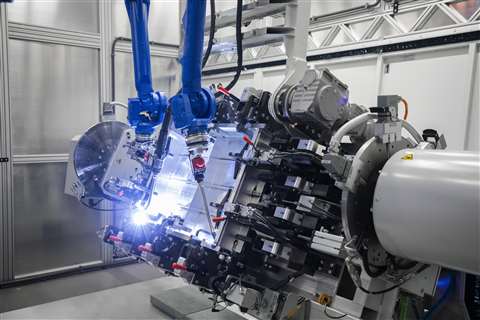 A battery tub gets welding together in a Webasto factory. (Photo: Webasto)
A battery tub gets welding together in a Webasto factory. (Photo: Webasto)
Quality on the line
When outfitting its battery facility, Webasto used as a springboard the processes it developed for its roofing systems. “Everything is done right, or we are not doing it,” Bowles said. “From the level of detail on the assembly line through to the end of line inspection, the roof systems go through an inspection that tests functionality and checks dozens of dimensions and fastener torque ratings. We catalog the end-of-line inspections in real time, and each roof gets a birth certificate.
“The process for the battery is even more detailed. This process helps the end customer know they have a good product, and they can root cause faster if there is an issue. Quality and safety are everything, and we will not waiver from that.”
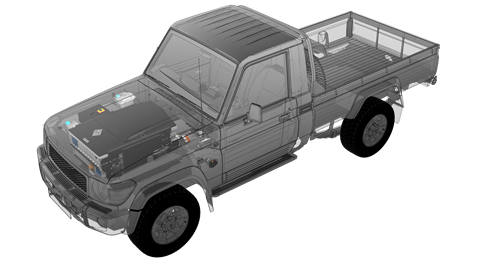 Huber Automotive AG, a vehicle electronics specialist, retrofitted Toyota Land Cruisers with lithium-ion battery packs for the underground mining industry and other extreme applications. Webasto’s standard battery system operates at 400 volts and has a capacity of 35 kW hours. Webasto said it also the program by actively contributing to design of the complete system. To ensure the battery pack was dimensioned to fit perfectly inside the existing vehicle’s body, for example, its housing was shortened in coordination between the companies. (Illustration: Webasto)
Huber Automotive AG, a vehicle electronics specialist, retrofitted Toyota Land Cruisers with lithium-ion battery packs for the underground mining industry and other extreme applications. Webasto’s standard battery system operates at 400 volts and has a capacity of 35 kW hours. Webasto said it also the program by actively contributing to design of the complete system. To ensure the battery pack was dimensioned to fit perfectly inside the existing vehicle’s body, for example, its housing was shortened in coordination between the companies. (Illustration: Webasto)
Written by Chad Elmore, this article originally appeared in the December 2022 issue of Diesel Progress.
STAY CONNECTED




Receive the information you need when you need it through our world-leading magazines, newsletters and daily briefings.
POWER SOURCING GUIDE
The trusted reference and buyer’s guide for 83 years
The original “desktop search engine,” guiding nearly 10,000 users in more than 90 countries it is the primary reference for specifications and details on all the components that go into engine systems.
Visit Now
CONNECT WITH THE TEAM










